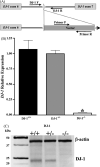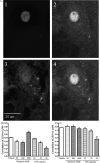Analysis of targeted mutation in DJ-1 on cellular function in primary astrocytes
- PMID: 19063952
- PMCID: PMC4632527
- DOI: 10.1016/j.toxlet.2008.11.008
Analysis of targeted mutation in DJ-1 on cellular function in primary astrocytes
Abstract
DJ-1 mutation induces early-onset Parkinson's disease, and conversely over-expression of DJ-1 is associated with cancer in numerous tissues. A gene-trap screening library conducted in embryonic stem cells was utilized for generation of a DJ-1 mutant mouse. Real-time PCR and immunoblotting were utilized to confirm functional mutation of the DJ-1 gene. Normal DJ-1 protein expression in adult mouse tissue was characterized and demonstrates high expression in brain tissue with wide systemic distribution. Primary astrocytes isolated from DJ-1(-/-) mice reveal a decreased nuclear localization of DJ-1 protein in response to rotenone or LPS, with a concomitant increase in mitochondrial localization of DJ-1 found only in the rotenone exposure. Resting mitochondrial membrane potential was significantly lower in DJ-1(-/-) astrocytes, as compared to controls. Our DJ-1 knockout mouse provides an exciting tool for exploring the molecular and physiological roles of DJ-1 to further explicate its functions in neurodegeneration.
Figures




References
-
- Allen JW, Mutkus LA, Aschner M. Isolation of neonatal rat cortical astrocytes for primary cultures. Curr. Protoc. Toxicol. Suppl. 2000;4:12.14.11–12.14.15. - PubMed
-
- Aschner M, Gannon M, Kimelberg HK. Manganese uptake and efflux in cultured rat astrocytes. J. Neurochem. 1992;58:730–735. - PubMed
-
- Betarbet R, Canet-Aviles RM, Sherer TB, Mastroberardino PG, McLendon C, Kim JH, Lund S, Na HM, Taylor G, Bence NF, Kopito R, Seo BB, Yagi T, Yagi A, Klinefelter G, Cookson MR, Greenamyre JT. Intersecting pathways to neurodegeneration in Parkinson's disease: effects of the pesticide rotenone on DJ-1, alpha-synuclein, and the ubiquitin-proteasome system. Neurobiol. Dis. 2006;22:404–420. - PubMed
-
- Betarbet R, Sherer TB, MacKenzie G, Garcia-Osuna M, Panov AV, Greenamyre JT. Chronic systemic pesticide exposure reproduces features of Parkinson's disease. Nat. Neurosci. 2000;3:1301–1306. - PubMed
-
- Boka G, Anglade P, Wallach D, Javoy-Agid F, Agid Y, Hirsch EC. Immunocytochemical analysis of tumor necrosis factor and its receptors in Parkinson's disease. Neurosci. Lett. 1994;172:151–154. - PubMed
Publication types
MeSH terms
Substances
Grants and funding
LinkOut - more resources
Full Text Sources
Other Literature Sources
Molecular Biology Databases

